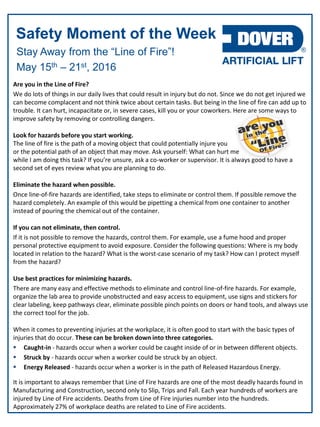
Dover ALS Safety Moment of the Week 16-May-2016
- 1. Stay Away from the “Line of Fire”! May 15th – 21st, 2016 Safety Moment of the Week Are you in the Line of Fire? We do lots of things in our daily lives that could result in injury but do not. Since we do not get injured we can become complacent and not think twice about certain tasks. But being in the line of fire can add up to trouble. It can hurt, incapacitate or, in severe cases, kill you or your coworkers. Here are some ways to improve safety by removing or controlling dangers. Look for hazards before you start working. The line of fire is the path of a moving object that could potentially injure you or the potential path of an object that may move. Ask yourself: What can hurt me while I am doing this task? If you’re unsure, ask a co-worker or supervisor. It is always good to have a second set of eyes review what you are planning to do. Eliminate the hazard when possible. Once line-of-fire hazards are identified, take steps to eliminate or control them. If possible remove the hazard completely. An example of this would be pipetting a chemical from one container to another instead of pouring the chemical out of the container. If you can not eliminate, then control. If it is not possible to remove the hazards, control them. For example, use a fume hood and proper personal protective equipment to avoid exposure. Consider the following questions: Where is my body located in relation to the hazard? What is the worst-case scenario of my task? How can I protect myself from the hazard? Use best practices for minimizing hazards. There are many easy and effective methods to eliminate and control line-of-fire hazards. For example, organize the lab area to provide unobstructed and easy access to equipment, use signs and stickers for clear labeling, keep pathways clear, eliminate possible pinch points on doors or hand tools, and always use the correct tool for the job. When it comes to preventing injuries at the workplace, it is often good to start with the basic types of injuries that do occur. These can be broken down into three categories. Caught-in - hazards occur when a worker could be caught inside of or in between different objects. Struck by - hazards occur when a worker could be struck by an object. Energy Released - hazards occur when a worker is in the path of Released Hazardous Energy. It is important to always remember that Line of Fire hazards are one of the most deadly hazards found in Manufacturing and Construction, second only to Slip, Trips and Fall. Each year hundreds of workers are injured by Line of Fire accidents. Deaths from Line of Fire injuries number into the hundreds. Approximately 27% of workplace deaths are related to Line of Fire accidents.
- 2. Safety Moment of the Week May 15th – 21st , 2016 Stay Away from the “Line of Fire”! Line of Fire hazards can hurt, incapacitate or, in severe cases, kill you or your coworkers. Here are some ways to improve safety by removing or controlling dangers. Look for hazards before you start working. Completing a Job Safety Analysis or Hazard Assessment is a great way to identify potential hazards that may cause injury. When completing the analysis or assessment ask yourself “What can hurt me while I’m doing this task”? If you’re unsure, ask a co-worker or supervisor. It’s always good to have a second set of eyes review what you’re planning to do. Common hazards include: Unexpected release of energy Unexpected machinery startup Hand and Power Tools Mobile Equipment Material Handling Unsafe Behavior’s When it comes to preventing injuries at the workplace, it is often good to start with the basic types of injuries that do occur. These can be broken down into three categories. • Caught-in - hazards occur when a worker could be caught inside of or in between different objects. • Struck by - hazards occur when a worker could be struck by an object. • Energy Released - hazards occur when a worker is in the path of Released Hazardous Energy. Examples of Best Practices for Preventing Incidents Watch out for moving vehicles (forklifts) at intersections and blind corners Before working near a door post a sign or prop the door open Do not push a door open rapidly or forcefully…Someone may be on the other side Stack materials carefully to prevent sliding, falling or collapsing Secure tool and materials for prevent them from falling on people below Wear hard hats if there is potential danger of something falling Never operate machinery without all guards in place Know the “DANGER” areas of the machine Utilize Lockout Tagout when conducing maintenance on machines Be aware of pinch points
